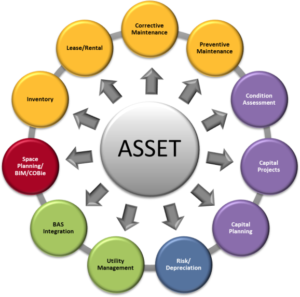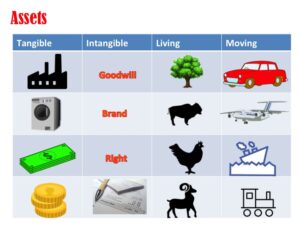
An asset is a resource owned or controlled by an individual, corporation, or government with the expectation that it will generate future cash flows. Common types of assets include: current, non-current, physical, intangible, operating, and non-operating. Correctly identifying and classifying the types of assets is critical to the survival of a company, specifically its solvency and associated risks.
The International Financial Reporting Standards (IFRS) framework defines an asset as follows: “An asset is a resource controlled by the enterprise as a result of past events and from which future economic benefits are expected to flow to the enterprise.”
An asset represents an economic resource for a company or represents access that other individuals or firms do not have. A right or other access is legally enforceable, which means economic resources can be used at a company’s discretion, and its use can be precluded or limited by an owner.
For an asset to be present, a company must possess a right to it as of the date of the financial statements. An economic resource is something that is scarce and has the ability to produce economic benefit by generating cash inflows or decreasing cash outflows.
Assets can be broadly categorized into short-term (or current) assets, fixed assets, financial investments, and intangible assets.
Examples of assets include:
- Cash and cash equivalents
- Inventory
- Investments
- PPE ( Property, Plant & Equipment)
- Vehicles
- Furniture
- Patents (intangible asset)
- Stock
Properties of an Asset
There are three key properties of an asset:
- Ownership: Assets represent ownership that can be eventually turned into cash and cash equivalents
- Economic Value: Assets have economic value and can be exchanged or sold
- Resource: Assets are resources that can be used to generate future economic benefits
 Classification of Assets
Classification of Assets
Assets are generally classified in three ways:
- Convertibility: Classifying assets based on how easy it is to convert them into cash.
- Physical Existence: Classifying assets based on their physical existence (in other words, tangible vs. intangible assets).
- Usage: Classifying assets based on their business operation usage/purpose.
Classification of Assets: Convertibility
If assets are classified based on their convertibility into cash, assets are classified as either current assets or fixed assets. An alternative expression of this concept is short-term vs. long-term assets.
1. Current Assets
Current assets are assets that can be easily converted into cash and cash equivalents (typically within a year). Current assets are also termed liquid assets and examples of such are:
- Cash
- Cash equivalents
- Short-term deposits
- Stock
- Marketable securities
- Office supplies
2. Fixed or Non-Current Assets
Non-current assets are assets that cannot be easily and readily converted into cash and cash equivalents. Non-current assets are also termed fixed assets, long-term assets, or hard assets. Examples of non-current or fixed assets include:
- Land
- Building
- Machinery
- Equipment
- Patents
- Trademarks
Classification of Assets: Physical Existence
If assets are classified based on their physical existence, assets are classified as either tangible assets or intangible assets.
1. Tangible Assets
Tangible assets are assets that have a physical existence (we can touch, feel, and see them). Examples of tangible assets include:
- Land
- Building
- Machinery
- Equipment
- Cash
- Office supplies
- Stock
- Marketable securities
2. Intangible Assets
Intangible assets are assets that do not have a physical existence. Examples of intangible assets include:
- Goodwill
- Patents
- Brand
- Copyrights
- Trademarks
- Trade secrets
- Permits
- Corporate intellectual property
Classification of Assets: Usage
If assets are classified based on their usage or purpose, assets are classified as either operating assets or non-operating assets.
1. Operating Assets
Operating assets are assets that are required in the daily operation of a business. In other words, operating assets are used to generate revenue from a company’s core business activities. Examples of operating assets include:
- Cash
- Stock
- Building
- Machinery
- Equipment
- Patents
- Copyrights
- Goodwill
2. Non-Operating Assets:
Non-operating assets are assets that are not required for daily business operations but can still generate revenue. Examples of non-operating assets include:
- Short-term investments
- Marketable securities
- Vacant land
- Interest income from a fixed deposit
Importance of Asset Classification
Classifying assets is important to a business. For example, understanding which assets are current assets and which are fixed assets is important in understanding the net working capital of a company. In the scenario of a company in a high-risk industry, understanding which assets are tangible and intangible helps to assess its solvency and risk. Determining which assets are operating assets and which assets are non-operating assets is important to understanding the contribution of revenue from each asset, as well as in determining what percentage of a company’s revenues comes from its core business activities.
Financial and Business expert having 30+ Years of vast experience in running successful businesses and managing finance.






